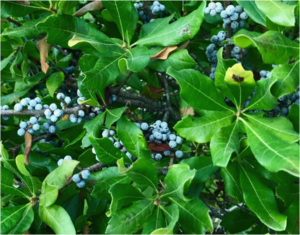Common Name: Bayberry
Specific Name: Morella pensylvanica, Myrica pensylvanica
Known Occurrence at Taylor Point:
Map areas: Cliffs 2B, Cliffs 2C
Category: Native, Shrub

Ecological Considerations:
Morella pensylvanica, commonly known as Bayberry, is an upright shrub, which is typically 5 to 8 feet in height, except on sand dunes and poor quality sites. The species has male and female plants. Flowers occur in early spring and are not showy. Female plants produce numerous small, blue-grey, waxy round fruit in the fall.
Bayberry is a native of the eastern coastal zone. Although adapted to a variety of soil conditions, it performs best on light textured soils. It naturally spreads to bare soil areas of sandy soils, but not into sod or cultivated sites.
Map areas where this plant can be used for revegetation:
Back Beach – 1F
Successional Field – 2D
Vegetated Parking Circle – 2F
Upper Beach – 1C
Northwest Shrubland – 2C
Propagation Mechanisms/Strategies for Encouraging its Establishment:
Best Planting Practices/Options and Pros and Cons of Options:
Bayberry is a natural selection for conservation plantings and for landscaping on coastal sands. Though not a legume, it does “fix” nitrogen and is an important constituent for revegetation efforts. In conservation plantings, this shrub does best where it is allowed to spread naturally by root suckers and where sand is accumulated. The nitrogen that becomes available over time will encourage other vegetation- generally a good thing unless invasive species show up. Shade from taller vegetation will not be tolerated by bayberry and the stand will be reduced.
Key Issues Regarding its Ecology ( e.g. Which Invasives Threaten it, What Conditions Favor it):
Associated Ecological Benefits:
Colonies of this salt spray-tolerant shrub provide excellent secondary stabilization and cover to the back dune areas of the mid-Atlantic coastline. Bayberry is used effectively in hedges, wildlife borders, and on road banks.
Because some leaves remain on the plant throughout most of the winter months, it provides year-round shelter for game and non-game animals alike. The berries provide a key energy source for swallows migrating south along the mid-Atlantic coast. These fruit are retained on the plant well into winter above any accumulated snow, making them readily available for bobwhite quail, ruffed grouse, ring-necked pheasant and numerous songbirds to consume.
Availability of Locally Sourced Seeds and Plants:
Edge of the Woods Native Plant Nursery – Orefield, PA
ArcheWild Native Nurseries – Quakertown, PA
Rhody Native
Case Studies of Native Plant Establishment Efforts/Lessons Learned:
Additional photos:

Sources cited:
Search at Rhode Island Native Plant Guide
USDA Fact Sheets
Missouri Botanical Garden
Wildflower.org
Key Words:
Native
Shrub
Morella pensylvanica
Myrica pensylvanica
Bayberry
